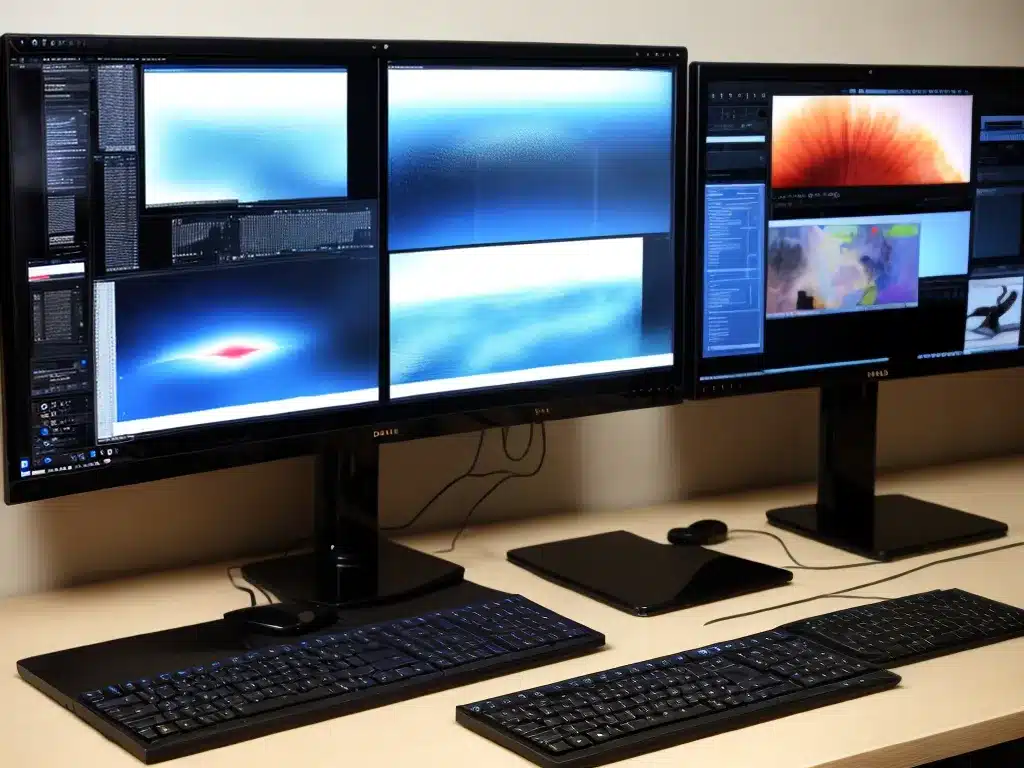
What is a Dual Monitor Setup?
A dual monitor setup refers to using two physical monitors with one computer. This allows you to expand your desktop area, giving you more screen real estate to work with.
With a dual monitor setup, I can have multiple applications open at once without having to flip between windows. For example, I may have my email open on one screen while writing articles on the other.
Benefits of using dual monitors:
-
Increased productivity – More screen space allows me to view more applications simultaneously. This saves time switching between windows.
-
Improved multitasking – I can have research materials open on one monitor while typing notes or articles on the other.
-
Less clutter – Applications can be organized across separate monitors, reducing desktop clutter on one screen.
-
Expanded visual area – Having two monitors gives me an expanded field of vision, which can reduce eye and neck strain.
What You Need for a Dual Monitor Setup
To set up dual monitors, you will need:
-
Computer – You will need a computer with sufficient graphics capability to support two monitors. Most modern desktops and laptops support dual monitor setups.
-
Two monitors – The monitors do not need to match, but having the same size/resolution monitors provides a more seamless experience.
-
Video cable(s) – This is used to connect the second monitor to your computer. Common cables include HDMI, DisplayPort, DVI, or VGA cables.
-
Desk space – Make sure your desk or workspace has room to accommodate two monitors side-by-side or vertically stacked.
-
Graphics card with multiple outputs – Your computer’s graphics card needs two output ports to connect both monitors. Most cards have HDMI, DisplayPort, DVI and/or VGA ports.
How to Set Up Dual Monitors on Windows
Step 1: Power off computer and connect second monitor. Use appropriate cable(s) to connect your second monitor to a video output port on your computer.
Step 2: Turn on computer and monitors. Allow Windows to detect the new display.
Step 3: Open display settings in Windows 10. Go to Start Menu > Settings > System > Display.
Step 4: Choose to extend displays. In display settings, scroll down to “Multiple Displays” and choose “Extend these displays” from the multiple display drop down menu. Click Apply.
Step 5: Arrange monitor positions. Drag and drop each numbered monitor icon to match the physical positioning of your two actual monitors.
Step 6: Adjust resolution. Ensure the resolution and orientation matches for each monitor. Make any other display customizations.
Step 7: Save changes. Confirm that your dual monitors are working as expected. Make any other customizations within Windows display settings.
How to Set Up Dual Monitors on Mac
Step 1: Connect the second monitor. Power off your Mac and connect the second monitor using a compatible video cable.
Step 2: Turn on Mac and monitors. Your Mac should automatically detect the new display.
Step 3: Open display preferences. Go to Apple Menu > System Preferences > Displays.
Step 4: Choose arrangement. Click the Arrangement tab and check “Mirror Displays” to show the same screen on both, or uncheck it to extend desktop across both.
Step 5: Customize settings. Adjust resolution, orientation, and other settings for each monitor as needed.
Step 6: Confirm setup. Verify dual monitors are working, then make any other customizations required in the display preferences.
Step 7: Save changes. Your Mac should now recognize the two connected monitors each time you boot it up.
Tips for Using a Dual Monitor Setup
Here are some tips to help you get the most productivity from a dual monitor setup:
-
Reduce bezel gap – Place monitors side-by-side to minimize the visual bezel gap in between. Alternatively, invest in dual monitors with thin bezels.
-
Keep taskbars to one side – Keeping taskbars and docks on just one monitor reduces clutter.
-
Use window snapping – Take advantage of window snapping/docking shortcuts in Windows and Mac OS to easily organize open application windows.
-
Coordinate wallpapers – Using matching or coordinated wallpapers across both monitors creates a more seamless dual monitor experience.
-
Adjust brightness – Don’t forget to adjust brightness/contrast on each monitor separately for ideal viewing.
-
Ergonomic positioning – Position monitors directly in front of you and at eye level to avoid neck strain.
With the right setup and some practice, using a dual monitor setup can significantly improve productivity and multitasking. Follow the steps outlined to successfully configure two monitors on your Windows or Mac computer.












